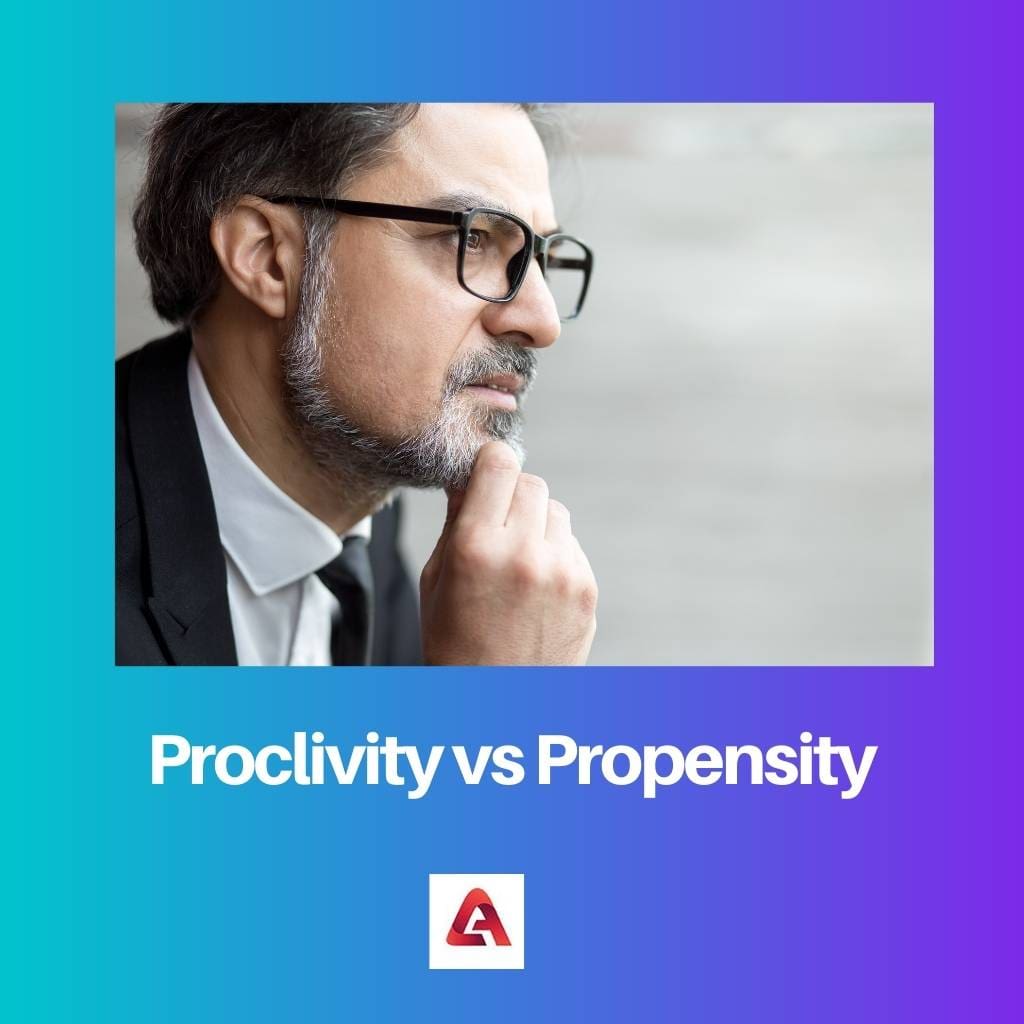While these two words might sound the same, they have very different meanings. Proclivity is a noun that means inclination or tendency to do something.
For example, if you have a proclivity for math, then you are more likely to take on more math courses in college than someone with little to no interest in mathematics. Propensity is also a noun that means the likelihood of something happening.
Key Takeaways
- Proclivity describes a natural inclination or predisposition towards a particular behavior or interest.
- Propensity refers to the likelihood of a certain outcome or action occurring based on an individual’s characteristics or circumstances.
- Both terms highlight the likelihood of specific behaviors or outcomes, with proclivity emphasizing innate tendencies and propensity focusing on situational factors.
Proclivity vs Propensity
Proclivity means a predisposition towards a specific behaviour or activity. This can be based on factors such as genetics, personality traits, or early experiences. Propensity implies a probability of exhibiting a specific behaviour or activity based on past experiences or environmental factors.

Proclivity is a noun that means inclination or tendency to do something.
For example, if you have a proclivity for math, then you are more likely to take on more math courses in college than someone with little to no interest in mathematics. Proclivity is the noun form of proclivity, which is an adjective.
Propensity is also a noun that means the likelihood of something happening. For example, if you are prone to getting sick, then it means that the likelihood of you getting sick is higher than someone who rarely gets cold.
It can also mean an inclination or tendency to do something. For instance, your propensity for reading may be lower if you read less compared with other people.
Comparison Table
| Parameters of Comparison | Proclivity | Propensity |
|---|---|---|
| Meaning | The definition of proclivity is a natural, inherent, or habitual disposition towards something. It can also mean ‘inclination to do wrong. | The definition of propensity is a natural or habitual inclination, tendency, or disposition. It can also mean “a person’s actual behaviour”. |
| Definition | Proclivity is a tendency to behave in one way rather than another. A person might have a strong proclivity towards violence. | Propensity can refer to the likelihood of a certain outcome. |
| Advantage | A proclivity is an inherent or natural inclination to do something. | A propensity is a natural or inherent tendency to do something. |
| Derived | The word “proclivity” comes from the Latin verb “proclivus,” which means “to lean forward.” | The word “propensity” comes from the Latin verb “propendere,” which means to have a natural leaning or tendency. |
| Example | If you have a proclivity for math, then you are more likely to take on more math courses in college than someone with little to no interest in mathematics. | If you are prone to getting sick, then it means that the likelihood of you getting sick is higher than someone who rarely gets a cold. |
What is Proclivity?
Proclivity is the tendency to favour one thing or person over another. For example, if someone has a proclivity for art, then they might have an inclination towards that profession and maybe better at it than others with other tendencies.
It can also mean a natural aptitude for something or doing things in a particular manner. Again using the example of art, it could be that one person has a proclivity for painting while another might have an aptitude for sculpture.
Proclivity means natural aptitude – this word has taken on another meaning over time and now refers to one’s ability or natural skill in a particular area.
For instance, if you have an inclination towards mathematics or another subject, then it could mean that you are more likely to understand the material and do well in future tests because of your proclivity for it.
It can also mean a natural aptitude for something or doing things in a particular manner. Again using the example of art, it could be that one person has a proclivity for painting while another might have an aptitude for sculpture.
If I’m not sure if my daughter has a natural tendency for something or just habits from doing it over and over again, she’ll be much better off with proclivity.
In order for someone to become a professional painter or sculptor, they need both types of tendencies-proclivities and propensities. It would be hard work, but for those who want to do it, they’ll manage.

What is Propensity?
Propensity (noun) is the natural inclination or tendency of a certain thing. It’s the state of being more prone to do something. The propensity of distribution to have outliers.
An act, occurrence, or event that is likely to happen. A strong disposition toward doing one particular activity as opposed to another. Propensity is the probability that an event will occur.
For example, suppose a population’s propensity to have blood pressure above 150/100 millimetres of mercury (mmHg) and their age is greater than 65 years old. In that case, they are at risk for stroke or another cardiovascular disease.
If more people in a population are left-handed, then the population is a dominant left-hand one.
In the case of propensity, a person is more likely to do something. It’s about probability (i.e., there are no guarantees that I will buy ice cream).
The advantage of using the word propensity is that it means “the probability that an event will occur.” The disadvantage to this word is that if you use it, many other words are used for similar contexts.
A person with propensities for both math and English would have more variety in their education (i.e. they would study and practice both languages).
The word is used to describe the tendency or likelihood that someone has towards particular activities, thoughts, feelings etc., rather than just one specific activity as opposed to another. For example, if a person is left-handed, then the population is a dominant left-hand one.

Main Differences Between Proclivity and Propensity
- Proclivity and propensity are measured on scales, with some people being more likely to act in one way than another.
- Proclivities are more specific than propensities because they express a predisposition for a certain type of behaviour. Propensity is the likelihood that someone will engage in an activity based on their interests or personality traits; it’s how prevalent something is among a population.
- When it comes to behaviours and tendencies related to drugs, alcohol, or gambling, for example, differences between proclivity and propensity are different in each individual person because of the availability of the substances and how they are used.
- Proclivity and propensity can be seen in people’s behaviour; some people are more prone or inclined to act in certain ways based on their personality.
- Proclivity and propensity range from low to high, with a higher score indicating that the person is more likely to do something than someone who scored lower on the scale.
- https://www.sciencedirect.com/science/article/pii/S0022435905000850
- http://rogosateaching.com/somgen290/cc_9.pdf

The article’s elucidation of proclivity and propensity was quite insightful, underscoring their unique implications in shaping behavioral tendencies. The in-depth examination contributes to a nuanced understanding of their distinctions.
Absolutely, the articulation of proclivity and propensity in the article was comprehensive, providing valuable insights into their nuanced meanings and contextual applications.
Fully agree with your assessment. The article’s detailed analysis of proclivity and propensity facilitated a profound understanding of their distinct characteristics and potential applications.
The article presented a comprehensive dissection of proclivity and propensity, offering valuable insights into their distinctions and potential applications. The detailed examination enhances comprehension of their nuanced implications.
I share your perspective. The comprehensive exploration of proclivity and propensity in the article offered clarity on their distinctive meanings and relevance in various settings.
The article presented a comprehensive comparison between proclivity and propensity, offering valuable insights into their distinct meanings and connotations. Understanding these nuanced differences is crucial for precise communication.
Absolutely, the comparison table effectively outlined the nuances between proclivity and propensity, allowing for a deeper understanding of these terms and their implications in diverse scenarios.
I agree with your assessment. The comprehensive comparison table facilitated clear comprehension of the differences between proclivity and propensity, highlighting their specific contexts and applications.
The article provided a thorough analysis of proclivity and propensity, elucidating their distinctions and significance. The detailed explanations and examples elucidated the implications of these terms in various contexts.
The article’s exploration of proclivity and propensity was commendable. The thorough analysis and nuanced explanations are valuable in understanding the intricacies of these terms.
Indeed, the examples accompanied by the explanation of proclivity and propensity were quite illuminating. It provided a solid grasp of the application of these terms in different scenarios.
The article effectively communicated the differences between proclivity and propensity, breaking down each term to offer a thorough understanding of their meanings and potential applications. It’s essential to recognize how these terms diverge in their implications.
I found the explanation on proclivity and propensity to be quite enlightening. The clarity provided has deepened my understanding of how these nuances are relevant to characterizing behaviors and inclinations.
The article provided an engaging depiction of proclivity and propensity, elucidating their underlying differences with precision. Appreciating these nuances contributes to refined language usage and nuanced expression.
Absolutely, the article effectively underscored the subtleties between proclivity and propensity, providing clarity on their individual connotations and relevance.
I concur with your assessment. The article’s elucidation of proclivity and propensity was indeed engaging, contributing to a deeper understanding of their nuanced implications.
The discussion on proclivity and propensity in the article is highly informative, particularly the comparison between these terms. The insights offered are crucial to discerning the subtle differences in their meanings and implications.
I share your sentiment. The article concisely outlined the differences between proclivity and propensity, providing clarity on their distinct connotations and applications.
Absolutely, the article’s treatment of proclivity and propensity was thought-provoking. Understanding these subtleties enhances precision in communication and comprehension.
The article’s treatment of proclivity and propensity was impressive, offering valuable elucidation on their differences and implications. The insights provided contribute to a deeper understanding of these nuanced terms.
The article offered a compelling exploration of proclivity and propensity, shedding light on their nuances and relevance. The emphasis on understanding their implications in various contexts is essential for informed communication.
The article provided an insightful explanation on the differences between proclivity and propensity, highlighting their meanings and usage. It’s important to understand how these terms emphasize different aspects of an individual’s likelihood to exhibit certain behaviors or interests.
The comparison table was particularly useful in grasping the distinctions between proclivity and propensity. It’s great to have a clear understanding of these terms and their derived meanings.
I completely agree with you. The key takeaways regarding proclivity and propensity were well-explained, providing clarity on their meanings and how they relate to behavior.